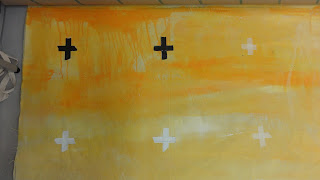Discuss trial options with Virginia - small scale trials watercolour silkscreen/attaching coloured card etc

Coloured card testers
Opt for working at smaller scale and staying with acrylics on canvas as colour values on watercolour/screen inks are markedly different.
Slight altering of colour saturation influencing spatial perception
WHAT NEXT ?: Further development of 'a personal language'
My Blog is an active part of developing my practice as an artist, part research/ exploration part record, part reflection - a test station for ideas. Steve Joy's description of his studio as a 'laboratory of the mind' seems apposite.A number of particularly strong interests have emerged during the course of ART 271:
- the power of understatement - the less there is the more you have to look - usually monochromatic (Agnes Martin / Max Cole / Rebecca Salter)
- the power of colour (Patrick Heron / Anselme Reyle / David Hockney)
- the tension between geometry/structure and accident
- spatial perception/manipulation within the picture plane
- reluctance to employ more overt landscape references (Hockney) but do not want to sever all links/association with landscape character/space
- the need for some rigorous thinking to underpin the work, avoid 'pattern making' and work through a set of ideas rather than constantly moving on without attempting to resolve issues
There is obviously some difficulty in reconciling the first two items. However the slow increase in technical competence is gradually opening up further possibilities e.g. the value of underpainting and the layering of washes.
Paintings to date have, deliberately, been relatively simple - exploring tone or colour, space, geometry and free washes....
Next series of paintings will aim to:
- Up the 'content' without returning to 'brush marks without purpose' - reintroduction of grids/structures, possibly based on plan layouts of gardens/buildings
- Retain limited palette exploring fine gradations of hue/saturation.

















.jpg)
























